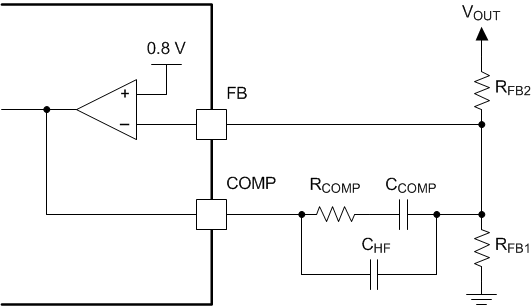JAJSFB3 April 2018 LM25119Q
PRODUCTION DATA.
- 1 特長
- 2 アプリケーション
- 3 概要
- 4 改訂履歴
- 5 概要(続き)
- 6 Pin Configuration and Functions
- 7 Specifications
-
8 Detailed Description
- 8.1 Overview
- 8.2 Functional Block Diagram
- 8.3
Feature Description
- 8.3.1 High Voltage Start-Up Regulator
- 8.3.2 UVLO
- 8.3.3 Enable 2
- 8.3.4 Oscillator and Sync Capability
- 8.3.5 Error Amplifiers and PWM Comparators
- 8.3.6 Ramp Generator
- 8.3.7 Current Limit
- 8.3.8 Hiccup Mode Current Limiting
- 8.3.9 Soft Start
- 8.3.10 HO and LO Output Drivers
- 8.3.11 Maximum Duty Cycle
- 8.3.12 Thermal Protection
- 8.4 Device Functional Modes
-
9 Application and Implementation
- 9.1 Application Information
- 9.2
Typical Applications
- 9.2.1
Dual-output Design Example
- 9.2.1.1 Design Requirements
- 9.2.1.2
Detailed Design Procedure
- 9.2.1.2.1 Timing Resistor
- 9.2.1.2.2 Output Inductor
- 9.2.1.2.3 Current Sense Resistor
- 9.2.1.2.4 Ramp Resistor and Ramp Capacitor
- 9.2.1.2.5 Output Capacitors
- 9.2.1.2.6 Input Capacitors
- 9.2.1.2.7 VCC Capacitor
- 9.2.1.2.8 Bootstrap Capacitor
- 9.2.1.2.9 Soft Start Capacitor
- 9.2.1.2.10 Restart Capacitor
- 9.2.1.2.11 Output Voltage Divider
- 9.2.1.2.12 UVLO Divider
- 9.2.1.2.13 MOSFET Selection
- 9.2.1.2.14 MOSFET Snubber
- 9.2.1.2.15 Error Amplifier Compensation
- 9.2.1.3 Application Curves
- 9.2.2 Two-Phase Design Example
- 9.2.1
Dual-output Design Example
- 10Power Supply Recommendations
- 11Layout
- 12デバイスおよびドキュメントのサポート
- 13メカニカル、パッケージ、および注文情報
パッケージ・オプション
メカニカル・データ(パッケージ|ピン)
- RTV|32
サーマルパッド・メカニカル・データ
- RTV|32
発注情報
9.2.1.2.11 Output Voltage Divider
RFB1 and RFB2 set the output voltage level, the ratio of these resistors is calculated from Equation 33.
Equation 33. 

Choosing a value of 2.21 kΩ for RFB1 results in a RFB2 value of 6.98 kΩ for a VOUT1 of 3.3 V. A reasonable guide is to select the value of RFB1 in the range between 500 Ω and 10 kΩ. The value of RFB1 must be large enough to keep the total divider power dissipation small.
 Figure 16. Feedback Configuration
Figure 16. Feedback Configuration